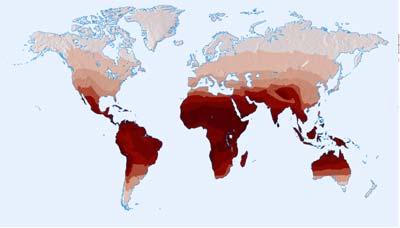
We usually observe variation in skin colour of all of us, skin colour ranges in variety from darkest brown to lightest pinkish-white hues. Human skin pigmentation is the because of the natural selection(Natural selection is considered as the gradual process through which biological traits become either more or less common within the population as a function of effect of inherited traits on differential reproductive success of organisms interacting with their environment.)
Variation in colour of skin can be regarded as a factor of lot many things altogether:
a) From sun,
b) Form our relatives or ancestors
c) Genes
d) From melanin present in our skin.
All these factors when taken in together amounts to your skin colour, with any of these reasons dominating more than others.
Melanin:
Melanin is a dark brown pigment or black in colour present within our skin. It is produced by special cells known as melanocytes situated under our layer of skin.
Function:
Function of melanin is to protect our skin’s outer layer from harmful Ultraviolet radiation from sun. These rays produce some of the chemical changes within our cell tissue that can then lead to the skin cancer. Melanin protects the skin by absorbing harmful Ultraviolet radiation (UV), acting as a sunscreen. It also neutralizes the free radicals, which are harmful chemicals that form within the skin after being damaged by the ultraviolet radiation.
Thus, it means that the more melanin we have, better the UV protection we have against the harmful radiation from rays of Sun. Similarly, amount of melanin we have in our skin determines how light or dark our complexion will be. This says that, People having light (fair) skin will have a little melanin rather those with darker skin; they will have much more melanin present in them. For those having yellow skin tone, this is determined by another pigment known as carotene, a yellow pigment.
Sun and melanin determining skin colour:
Person who is spending large amount of time in sun will have darker as the melanin within the skin becomes more active generating more of this pigment to decrease the harmful UV effects of sun. This same principle is used in tanning. In this way sun and melanin both determined our tone of skin colour. This also accounts for “Why do people from the tropics generally have darker skin color that those who live in colder climates”.
How much genes accounts for the color of skin:
The amount of (melanin) pigment we have in our skin is also decided by the genes we inherit. Genes (short pieces of DNA) refers to the units of information within the cells of our body. Genes create the blueprint, or plan, for the human body and its functions. It is thus through our genes that the traits are carried down from the parents to offspring, in a process known as heredity. This is what is responsible for our genetic makeup (called as genotype).
Now when relating the genes to our skin colour, it can be explained with evolution determining people having dark skin or light skin colour. Early man thousands years ago have their body covered with hair protecting their skin form UV rays (Living in equatorial Africa) now, with evolution hair growth diminishes leaving their skin exposed to sunrays that offers minimal protection. Fair skinned person living nearby the equator is more susceptible to various health risks, such as skin cancer (melanoma). On the other hand, a person having darker skin has greater protection and therefore had a greater benefit of survival. Thus, a process known as Natural selection, filters out specific parental genes (those for lighter skin) within successive generations, generating offspring having slightly different characteristics and less genetic variability.

Moving from equatorial region of Africa to Asia and Europe that are closer to poles, the northern climate here is much cooler because of the fact that sun radiation becomes much less intense especially at the time of winter season where the sun light gets even further weakened. As a result, the production of melanin gradually decreased to allow acclimation to the climates. This means that a dark skinned person residing in polar latitudes will slowly get evolved into people having lighter skin color such as white.
Importance of UV radiation:
The equatorial climate where there is too much UV light poses a serious health risks like skin cancer, likewise too, little UV light can also be seriously harmful for our health. The reason for this is that, UV light is essential for our bodies to make vitamin D which forms within the skin when exposed to sunlight. Vitamin D is needed by the human body to build strong bones. Thus, a dark skinned person residing near the poles is more susceptible to health risk such as vitamin D deficiency which causes the disease known as Rickets.
Today in modern times, people has been moving around entire globe, visiting, working and living in different countries having different climatic conditions having a population with all skin type. All this is possible due to technology and science. People can freely travel and live in other countries without being harmed because one skin is too light or too dark. You can now: take supplements of vitamin D, travel in cars, planes, trains, ships, and wear protective clothing as per the weather climatic conditions and so on.